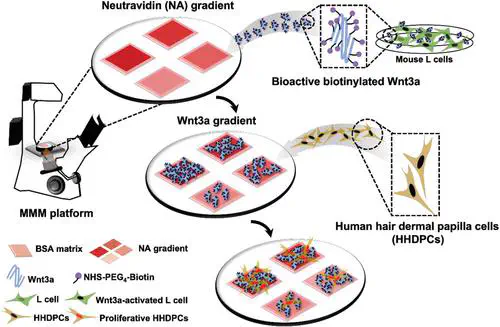New Paper: A Bio-Functional Wnt3a Gradient Microarray for Cell Niche Studies

We used our multiphoton microfabrication and micropatterning (MMM) technology to immobilize a concentration gradient of Wnt3a on a protein substrate via neutravidin-biotin interactions in a quantitatively and spatially controllable manner.
Check out the published paper here: https://doi.org/10.1002/adfm.202301941
Abstract
The Wingless/Integrated (Wnt) signaling is a central player in regulating multiple cellular events ranging from developmental process, adult homeostasis to tumorigenesis. In native microenvironments, Wnt signals often function through the concentration gradients between the secreting site and the targeting site. Hence, presenting Wnt molecules in a concentration gradient in vitro in a controllable manner recapitulates the native Wnt niche. Nevertheless, most in vitro Wnt niche models, where the ligands are homogeneously immobilized on material surface, fail in reconstituting the concentration gradient of Wnt as that in vivo. Herein, using a previously established Multiphoton Microfabrication and Micropatterning (MMM) technology, a concentration gradient of Wnt3a is immobilized on a protein substrate via neutravidin-biotin interactions, in a quantitatively and spatially controllable manner. Such Wnt3a gradient is bioactive as it triggers a dose- and time-dependent upregulation of β-catenin and cell proliferation, in model mouse L cells. Most importantly, human hair dermal papilla cells (HHDPCs) cultured in a cell niche with Wnt3a gradient proliferate in a Wnt3a-gradient-dependent manner and exhibit a Wnt3a-gradient-dependent hair-inductive phenotype including Wnt/β-catenin signaling activation and alkaline phosphatase (ALP) expression. This work contributes to the future development of a hair follicle inductivity biochip for screening of drugs and therapeutics on hair regeneration.